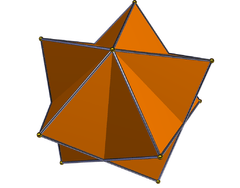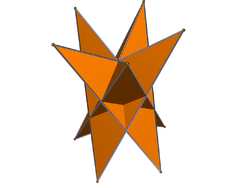Pentagrammic bipyramid
| Pentagrammic bipyramid | |
|---|---|
 | |
| Type | Star bipyramid |
| Schläfli symbol | {} + {5/2} |
| Coxeter diagram | |
| Faces | 10 triangles |
| Edges | 15 |
| Vertices | 7 |
| Face configuration | V4.4.5 |
| Symmetry group | D5h, [5,2], (*225), order 20 |
| Rotation group | D5, [5,2]+, (225), order 10 |
| Dual | pentagrammic prism |
| Properties | face-transitive, (deltahedron) |
In geometry, the pentagrammic bipyramid (or dipyramid) is first of the infinite set of face-transitive star bipyramids containing star polygon arrangement of edges. It has 10 intersecting isosceles triangle faces. It is topologically identical to the pentagonal bipyramid.
Each star bipyramid is the dual of a star polygon based uniform prism.
Related polyhedra
There are two pentagrammic trapezohedra (or deltohedra), being dual to the pentagrammic antiprism and pentagrammic crossed antiprism respectively, each having intersecting kite-shaped faces (convex or concave), and a total of 12 vertices:
| {5/2} trapezohedron | {5/3} trapezohedron |
|---|---|
 |
 |
References
External links
This article is issued from Wikipedia - version of the 9/22/2015. The text is available under the Creative Commons Attribution/Share Alike but additional terms may apply for the media files.